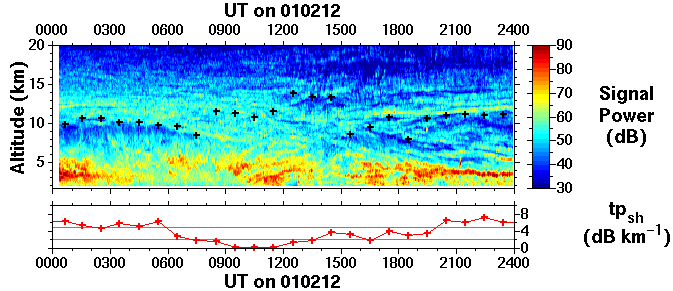
Lower VHF radar signals are either backscattered or parially reflected from small magnitude (< 10-6) metre-scale irregularities of radio refractive index; the radar return signal power is related to the vertical gradient of refractive index. Below approximately 8 km this depends largely on the "humidity field", i.e. the specific humidity and its vertical gradient, which can give rise to characteristic signatures in the radar return signal power. Rain fall can also give rise to a characteristic signature in the radar return signal power at these altitudes. Above approximately 8 km, however, variations of radar return signal power depend primarily on the static stability of the atmosphere. It is thus possible to infer the tropopause altitude, indicated by the crosses, and sharpness, indicated by the value of tpsh, from an objective algorithm.
Tropopause altitude/sharpness determination algorithm:
The vertical beam signal power, in dB units, is smoothed in altitude
by an 1800 m running mean and then the vertical gradient is calculated
over the same interval. The tropopause altitude is that at which the
gradient has its maximum value and tpsh is equal to this
value.
- tpsh > 5 dB km-1 corresponds to a
definite tropopause
- tpsh < 2 dB km-1 corresponds to an indefinite tropopause
- 2 dB km-1 < tpsh < 5 dB km-1 corresponds to a tropopause of intermediate sharpness
- tpsh < 2 dB km-1 corresponds to an indefinite tropopause
For the data shown above this algorithm has been applied to 1 hour median profiles of radar return signal power. The radar is effectively detecting a 'static stability tropopause', i.e. where the Brunt-Väisälä frequency changes most rapidly with altitude between (low) tropospheric and (high) stratospheric values. In the case of an indefinite tropopause, i,e between 0800 and 1400 UT, there is only a very gradual increase in static stability with increasing altitude and so the tropopause altitude inferred from the algorithm does not necessarily have any significance; between 1200 and 1500 UT the algorithm is merely picking out the feature which causes the most rapid increase of signal strength/static stability with altitude. The reason for smoothing and taking gradients over 1800 m is to reject any small (vertical) scale features which are characterised by sharp increases in signal strength. Even so the algorithm does sometimes pick out such features, particularly in the case of frontal zones, which can also be characterised by an enhancement of static stability, when they are close to the actual tropopause level; such errors can typically be easily identified "by eye".
- Internal Links:
- Return to top of page
- The NERC MST Radar
- The radio refractive index of the atmosphere
- Radar return mechanisms
- The signature of humidity on MST Radar return signals
- The signature of precipitation on MST Radar return signals
- Horizontal wind
- Vertical_velocity
- Aspect sensitivity
- Spectral width
- The NERC MST Radar

 THE NERC MST RADAR FACILITY AT ABERYSTWYTH
THE NERC MST RADAR FACILITY AT ABERYSTWYTH